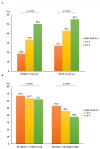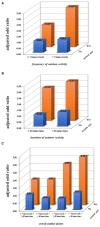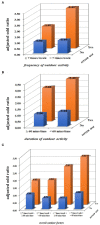Combination Effect of Outdoor Activity and Screen Exposure on Risk of Preschool Myopia: Findings From Longhua Child Cohort Study
- PMID: 33748061
- PMCID: PMC7973103
- DOI: 10.3389/fpubh.2021.607911
Combination Effect of Outdoor Activity and Screen Exposure on Risk of Preschool Myopia: Findings From Longhua Child Cohort Study
Abstract
Evidence regarding screen use and outdoor activity during very early childhood (i. e., from aged 1 to 3 years) and their potential combined links to the later preschool myopia is limited. This information is needed to release effective public health messages and propose intervention strategies against preschool myopia. We collected information regarding very early childhood screen use, outdoor activity and the kindergartens vision screenings of 26,611 preschoolers from Longhua Child Cohort Study by questionnaires. Logistic regression models were used to examine the associations between reported outdoor activity, screen use from 1 to 3 years of age, and preschool myopia. Throughout very early childhood, from 1 to 3 years, the proportion of children exposed to screens increased (from 35.8 to 68.4%, p < 0.001), whereas the proportion of children who went outdoors ≥7 times/week (67.4-62.1%, p < 0.001) and who went outdoors for ≥60 min/time (53.3-38.0%, p < 0.001) declined. Exposure to fixed screen devices [adjusted odds ratio (AOR) = 2.66, 95% confidence interval (CI) = 2.09-3.44], mobile screen devices (AOR = 2.76, 95% CI = 2.15-3.58), and limited outdoor activity (AOR = 1.87, 95% CI = 1.42-2.51) during early childhood were associated with preschool myopia. Among children whose parents were myopic, the interactions between outdoor activity and fixed or mobile screen use on later preschool myopia were significant; the ORs and 95% CI were 3.34 (1.19-9.98) and 3.04 (1.06-9.21), respectively. Our findings suggest the possibility that the impact of screen exposure during early childhood on preschool myopia could be diminished by outdoor activity for children whose parents have myopia.
Keywords: early childhood; interaction; myopia; outdoor activity; screen use.
Copyright © 2021 Huang, Schmid, Yin, Zhang, Wu, Yang, Ruan, Jiang, Wu and Chen.
Conflict of interest statement
The authors declare that the research was conducted in the absence of any commercial or financial relationships that could be construed as a potential conflict of interest.
Figures



Similar articles
-
Association between greater residential greenness and decreased risk of preschool myopia and astigmatism.Environ Res. 2021 May;196:110976. doi: 10.1016/j.envres.2021.110976. Epub 2021 Mar 6. Environ Res. 2021. PMID: 33684414
-
Association between early childhood outdoor activity and anxiety symptoms in preschoolers.BMC Psychiatry. 2025 Apr 17;25(1):388. doi: 10.1186/s12888-025-06831-2. BMC Psychiatry. 2025. PMID: 40247256 Free PMC article.
-
Associations Between Screen Exposure in Early Life and Myopia amongst Chinese Preschoolers.Int J Environ Res Public Health. 2020 Feb 7;17(3):1056. doi: 10.3390/ijerph17031056. Int J Environ Res Public Health. 2020. PMID: 32046062 Free PMC article.
-
Association between digital smart device use and myopia: a systematic review and meta-analysis.Lancet Digit Health. 2021 Dec;3(12):e806-e818. doi: 10.1016/S2589-7500(21)00135-7. Epub 2021 Oct 5. Lancet Digit Health. 2021. PMID: 34625399
-
Dose-Response Relationship of Outdoor Exposure and Myopia Indicators: A Systematic Review and Meta-Analysis of Various Research Methods.Int J Environ Res Public Health. 2019 Jul 21;16(14):2595. doi: 10.3390/ijerph16142595. Int J Environ Res Public Health. 2019. PMID: 31330865 Free PMC article.
Cited by
-
Global risk factor analysis of myopia onset in children: A systematic review and meta-analysis.PLoS One. 2023 Sep 20;18(9):e0291470. doi: 10.1371/journal.pone.0291470. eCollection 2023. PLoS One. 2023. PMID: 37729320 Free PMC article.
-
Association between maternal polycystic ovary syndrome and attention-deficit/hyperactivity disorder in offspring aged 3-6 years: A Chinese population-based study.Front Public Health. 2023 Jan 9;10:1032315. doi: 10.3389/fpubh.2022.1032315. eCollection 2022. Front Public Health. 2023. PMID: 36699874 Free PMC article.
-
Refraction and ocular biometric parameters in 3-to 6-year-old preschool children : a large-scale population-based study in Chengdu, China.BMC Ophthalmol. 2024 May 6;24(1):207. doi: 10.1186/s12886-024-03467-w. BMC Ophthalmol. 2024. PMID: 38711043 Free PMC article.
-
Meibomian gland atrophy in children with allergic conjunctivitis.Int J Ophthalmol. 2025 May 18;18(5):832-839. doi: 10.18240/ijo.2025.05.07. eCollection 2025. Int J Ophthalmol. 2025. PMID: 40385119 Free PMC article.
-
The effects of exposure to solar radiation on human health.Photochem Photobiol Sci. 2023 May;22(5):1011-1047. doi: 10.1007/s43630-023-00375-8. Epub 2023 Mar 1. Photochem Photobiol Sci. 2023. PMID: 36856971 Free PMC article.
References
-
- Rudnicka AR, Kapetanakis VV, Wathern AK, Logan NS, Gilmartin B, Whincup PH, et al. . Global variations and time trends in the prevalence of childhood myopia, a systematic review and quantitative meta-analysis: implications for aetiology and early prevention. Br J Ophthalmol. (2016) 100:882–90. 10.1136/bjophthalmol-2015-307724 - DOI - PMC - PubMed
Publication types
MeSH terms
LinkOut - more resources
Full Text Sources
Other Literature Sources

